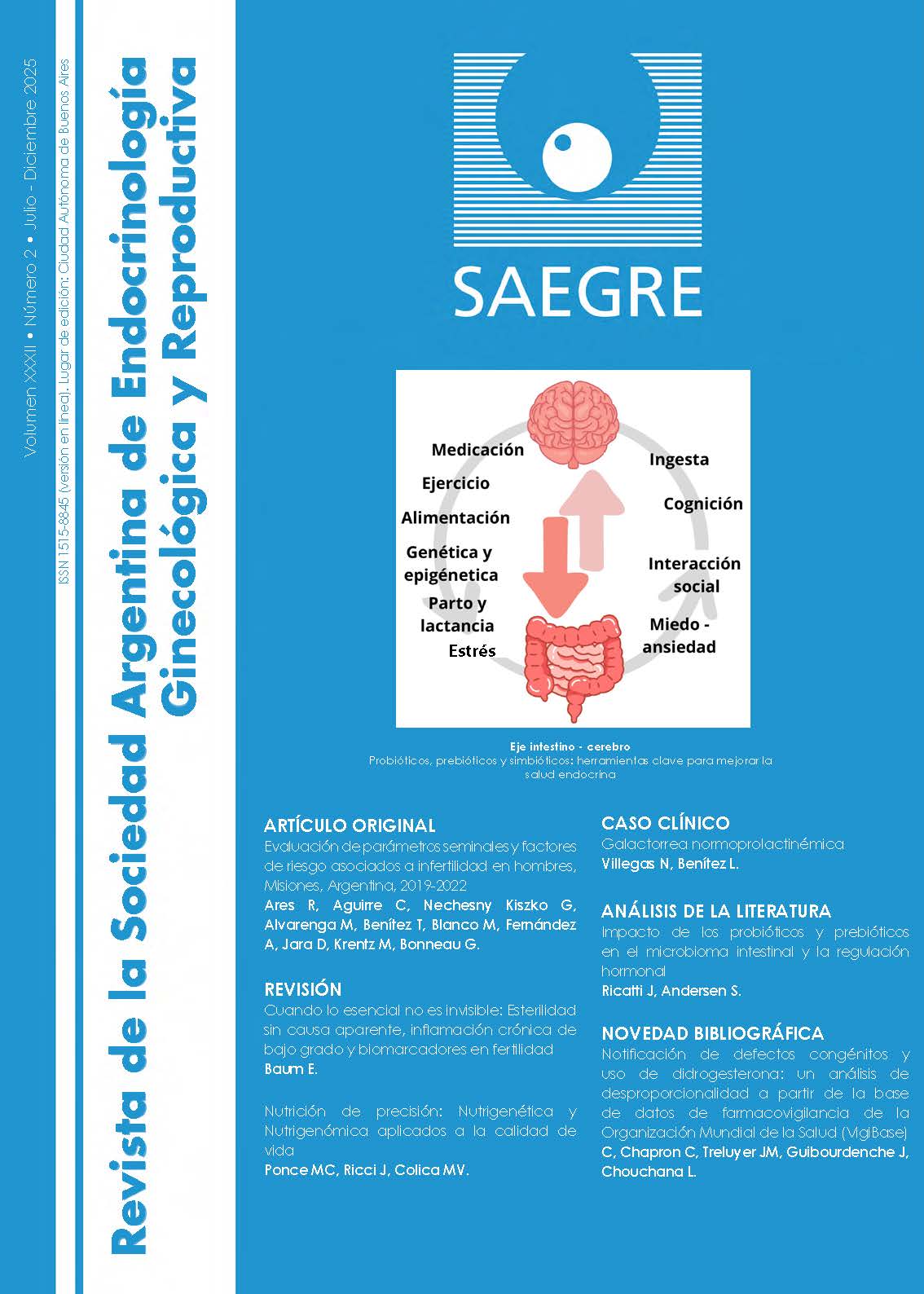Resumen
En el presente trabajo de Basnet J et al., destacan de manera enfática la asociación existente entre la microbiota —entendida como el conjunto de microorganismos que habitan principalmente el colon— y diversos procesos relacionados con el metabolismo y la funcionalidad hormonal. Asimismo, se analiza el papel fundamental del microbioma, definido como el conjunto del material genético de la microbiota en la regulación del metabolismo hormonal a través de la síntesis y actividad enzimática llevada a cabo por estos microorganismos.
Citas
Kho ZY, Lal SK.The Human Gut Microbiome – A Potential Controller of Wellness and Disease. Front. Microbiol., 2018; 9:1835. doi: 10.3389/fmicb.2018.01835
Human Microbiome Project Consortium.. Structure, function and diversity of the healthy human microbiome. Nature, 2012; 486(7402): 207–214. https://doi.org/10.1038/nature11234
Thursby E, Juge N. Introduction to the human gut microbiota. Biochem J, 2017; 474 (11): 1823–1836. https://doi.org/10.1042/BCJ20160510
Gilbert JA, Blaser MJ, Caporaso JG, Jansson JK, Lynch SV, Knight R. Current understanding of the human microbiome. Nature Medicine, 2018; 24 (4): 392–400. https://doi.org/10.1038/nm.4517
Rothschild D, Weissbrod O, Barkan E, Kurilshikov A, Korem T, Zeevi D, et al. Environment dominates over host genetics in shaping human gut microbiota. Nature, 2018; 555(7695): 210–215. https://doi.org/10.1038/nature25973
Mehta I, Juneja K, Nimmakayala T, Bansal L, Pulekar S, Duggineni D, et al. Gut Microbiota and Mental Health: A Comprehensive Review of Gut-Brain Interactions in Mood Disorders. Cureus, 2025; Mar 30;17(3): e81447. doi:10.7759/cureus.81447. PMID: 40303511; PMCID: PMC12038870.
Ortega MA, Álvarez-Mon MA, García-Montero C, Fraile Martínez Ó, Monserrat J, Martínez-Rosa L, et al. Microbiota– gut–brain axis mechanisms in the complex network of bipolar disorders: potential clinical implications and translational
opportunities. Mol Psychiatry, 2023; 28:2645–2673. https://doi.org/10.1038/s41380-023-01964-w
Lim MY, You HJ, Yoon HS, Kwon B, Lee JY, Lee S, et al. The effect of heritability and host genetics on the gut microbiota and metabolic syndrome. Gut. 2017 Jun;66(6):1031-1038. doi: 10.1136/gutjnl-2015-311326. Epub 2016 Apr 6. PMID: 27053630.
Ortega-Vega EL, Guzmán-Castañeda SJ, Campo O,Velásquez-Mejía EP, de la Cuesta-Zuluaga J, Bedoya G, et al. Variants in genes of innate immunity, appetite control andenergy metabolism are associated with host cardiometabolic health and gut microbiota composition. Gut Microbes, 2020 May 3;11(3):556-568. doi: 10.1080/19490976.2019.1619440. Epub 2019 Jun 3. PMID: 31154934; PMCID: PMC7524339.
Giampaoli O, Conta G, Calvani R, Miccheli A. Can the FUT2 Non-secretor Phenotype Associated With Gut Microbiota Increase the Children Susceptibility for Type 1 Diabetes? A Mini Review. Front Nutr. 2020 Dec 23;7:606171. doi: 10.3389/fnut.2020.606171. PMID: 33425974; PMCID: PMC7785815.
Nakata T, Creasey EA, Kadoki M, Lin H, Selig MK, Yao J, et al. A missense variant in SLC39A8 confers risk for Crohn’s disease by disrupting manganese homeostasis and intestinal barrier integrity. Proc Natl Acad Sci USA, 2020; Nov 17;117(46):28930-28938. doi: 10.1073/pnas.2014742117. Epub 2020 Nov 2. PMID: 33139556; PMCID: PMC7682327.
Li D, Achkar JP, Haritunians T, Jacobs JP, Hui KY, D’Amato M, et al. A Pleiotropic Missense Variant in SLC39A8 Is Associated With Crohn’s Disease and Human Gut Microbiome Composition. Gastroenterology, 2016 Oct;151(4):724-32. doi: 10.1053/j.gastro.2016.06.051. Epub 2016 Aug 1. PMID: 27492617; PMCID: PMC5037008.
Hugot JP, Chamaillard M, Zouali H, Lesage S, Cézard JP, Belaiche J, et al. Association of NOD2 leucine-rich repeat variants with susceptibility to Crohn’s disease. Nature, 2001;May 31;411(6837):599-603. doi: 10.1038/35079107. PMID:11385576.
Ogura Y, Bonen DK, Inohara N, Nicolae DL, Chen FF, Ramos R, et al. A frameshift mutation in NOD2 associated with susceptibility to Crohn’s disease. Nature, 2001; May 31;411(6837):603-6. doi: 10.1038/35079114. PMID: 11385577.
Esta obra está bajo licencia internacional
Los documentos publicados en esta revista están bajo la licencia Creative Commons Atribución NoComercial-4.0 Internacional

